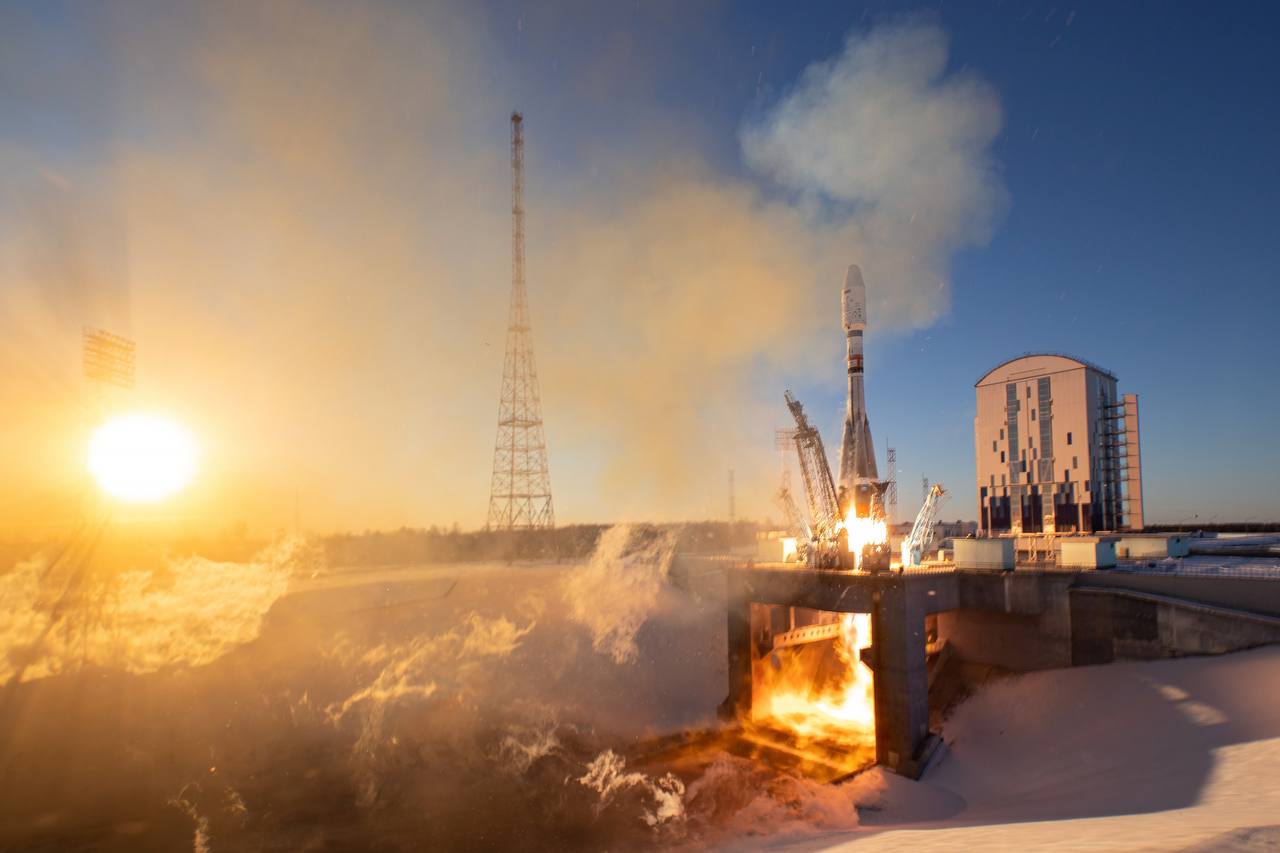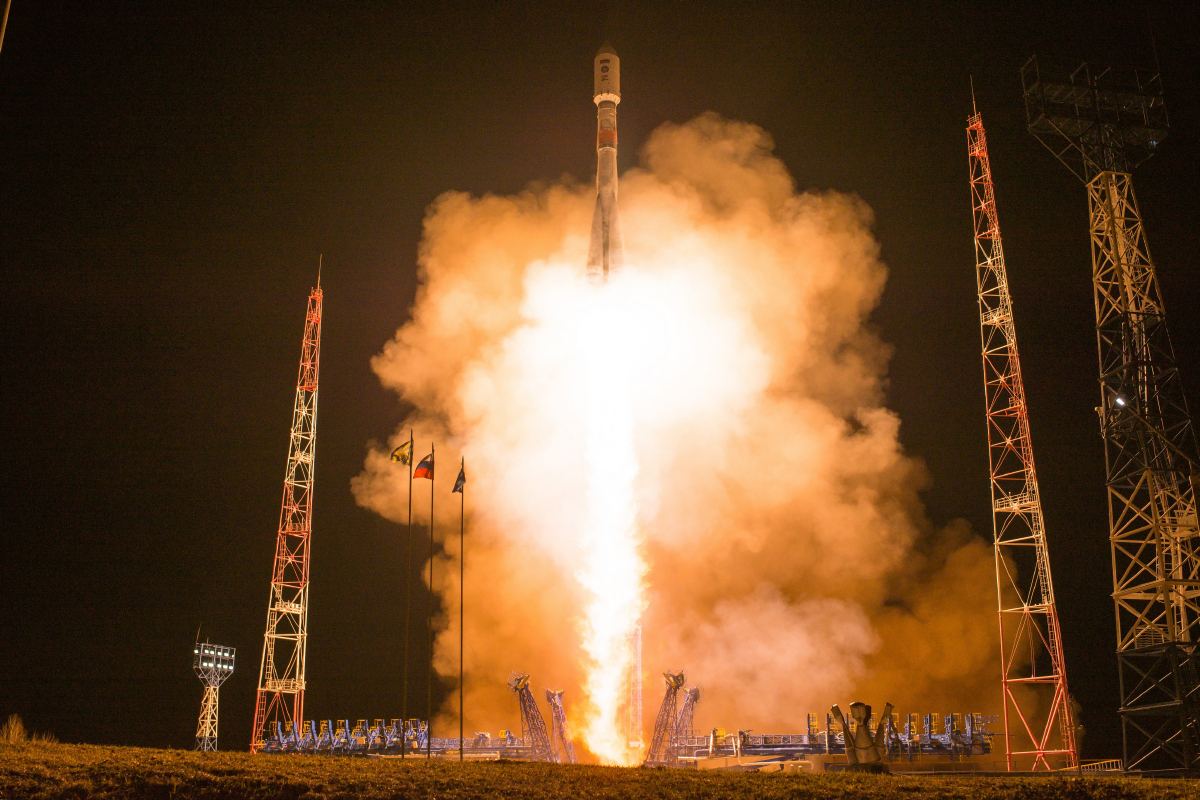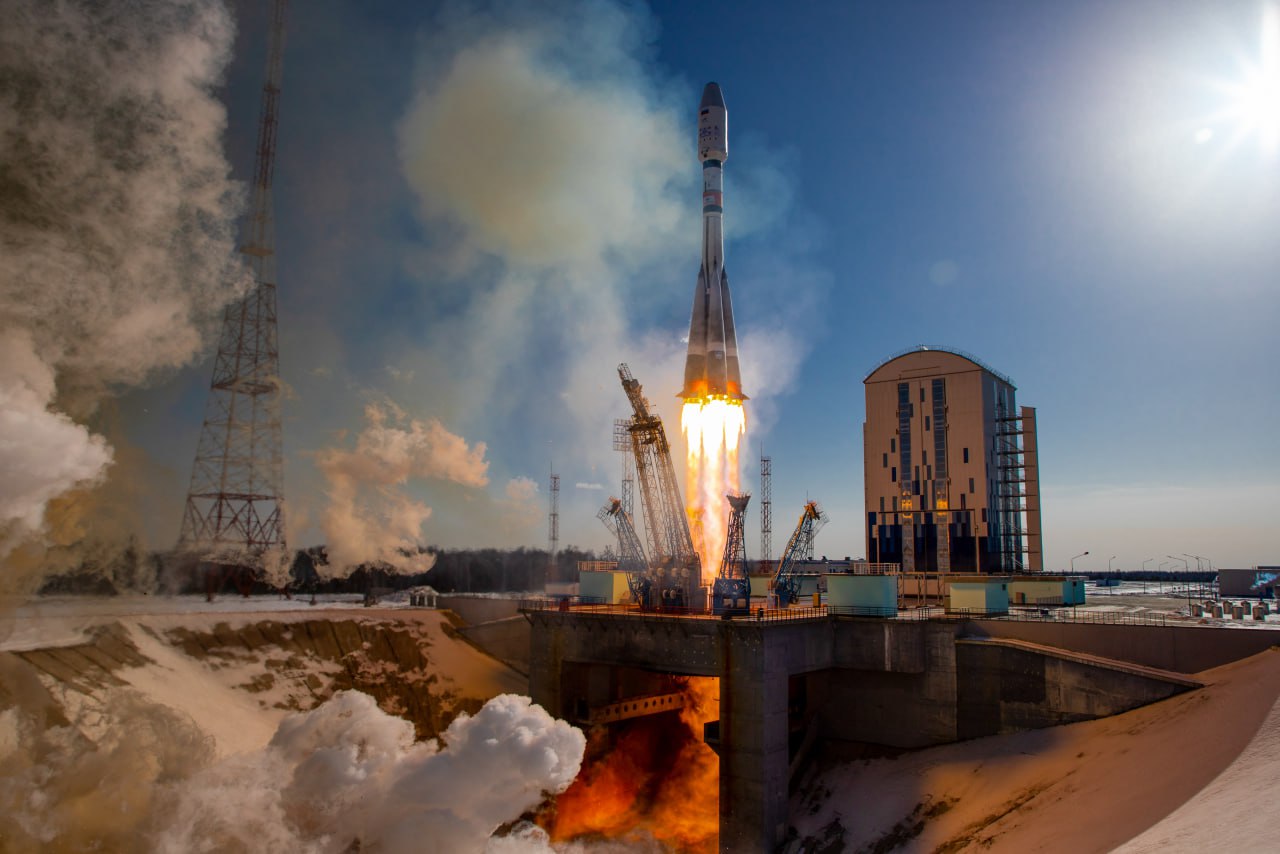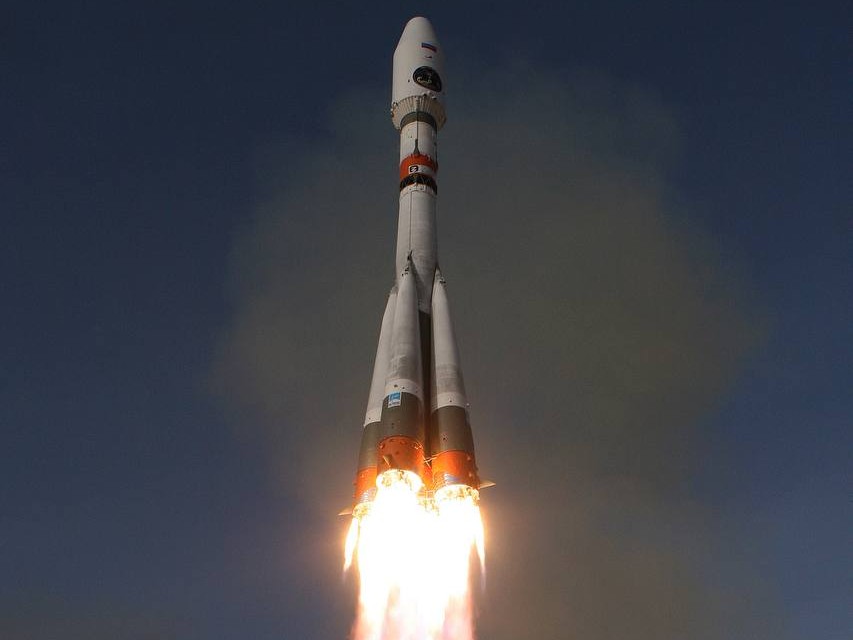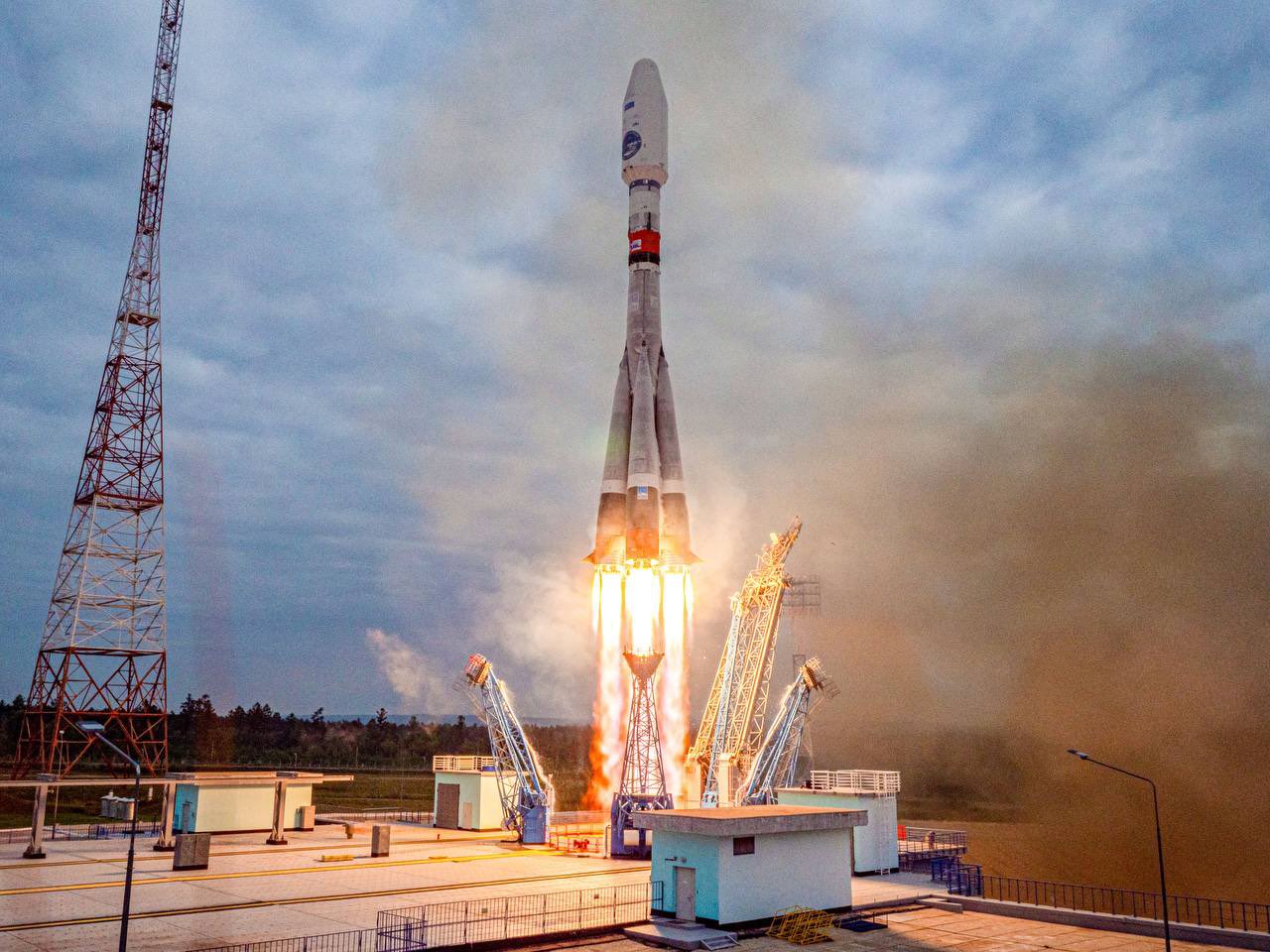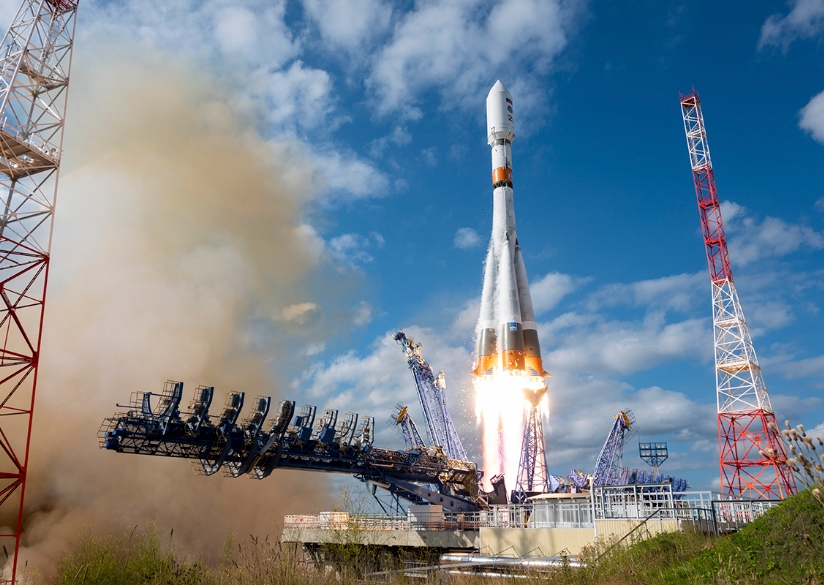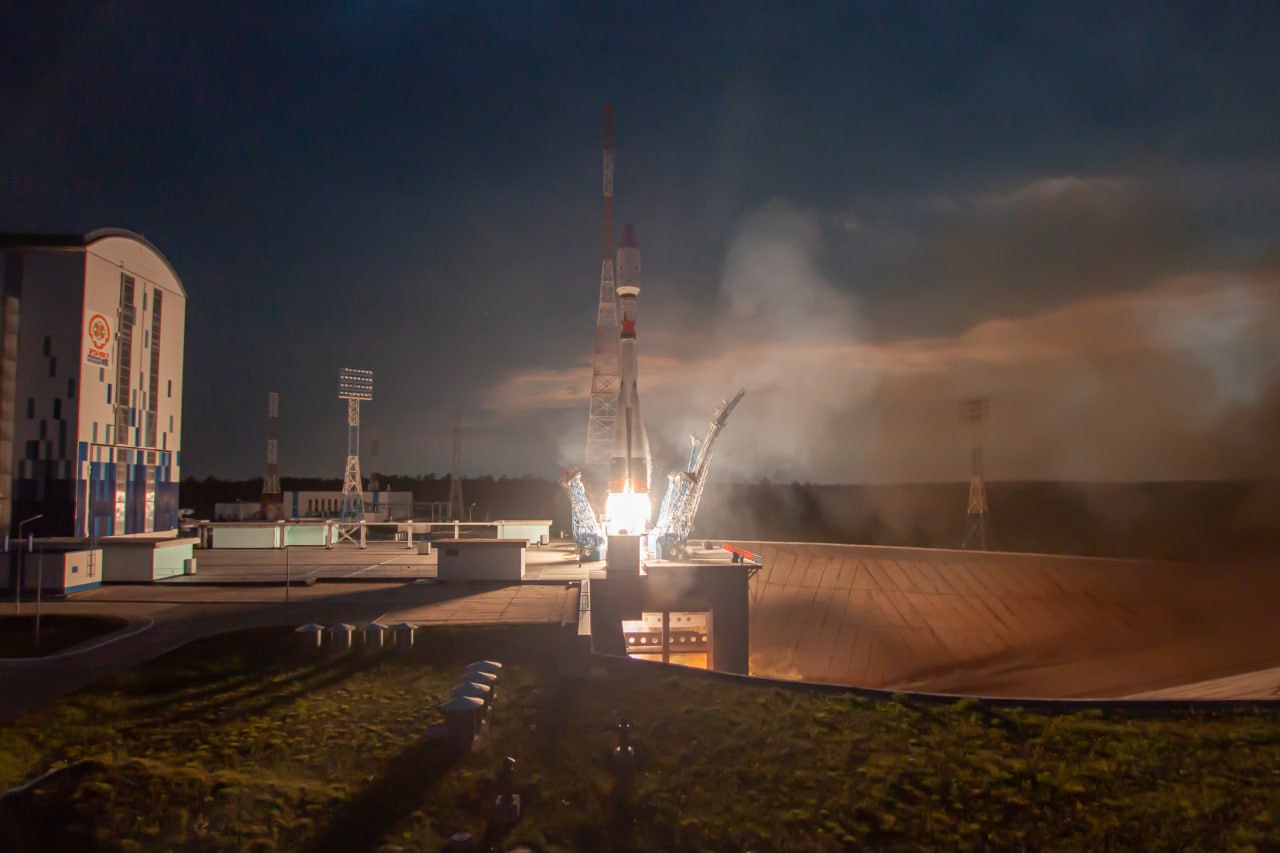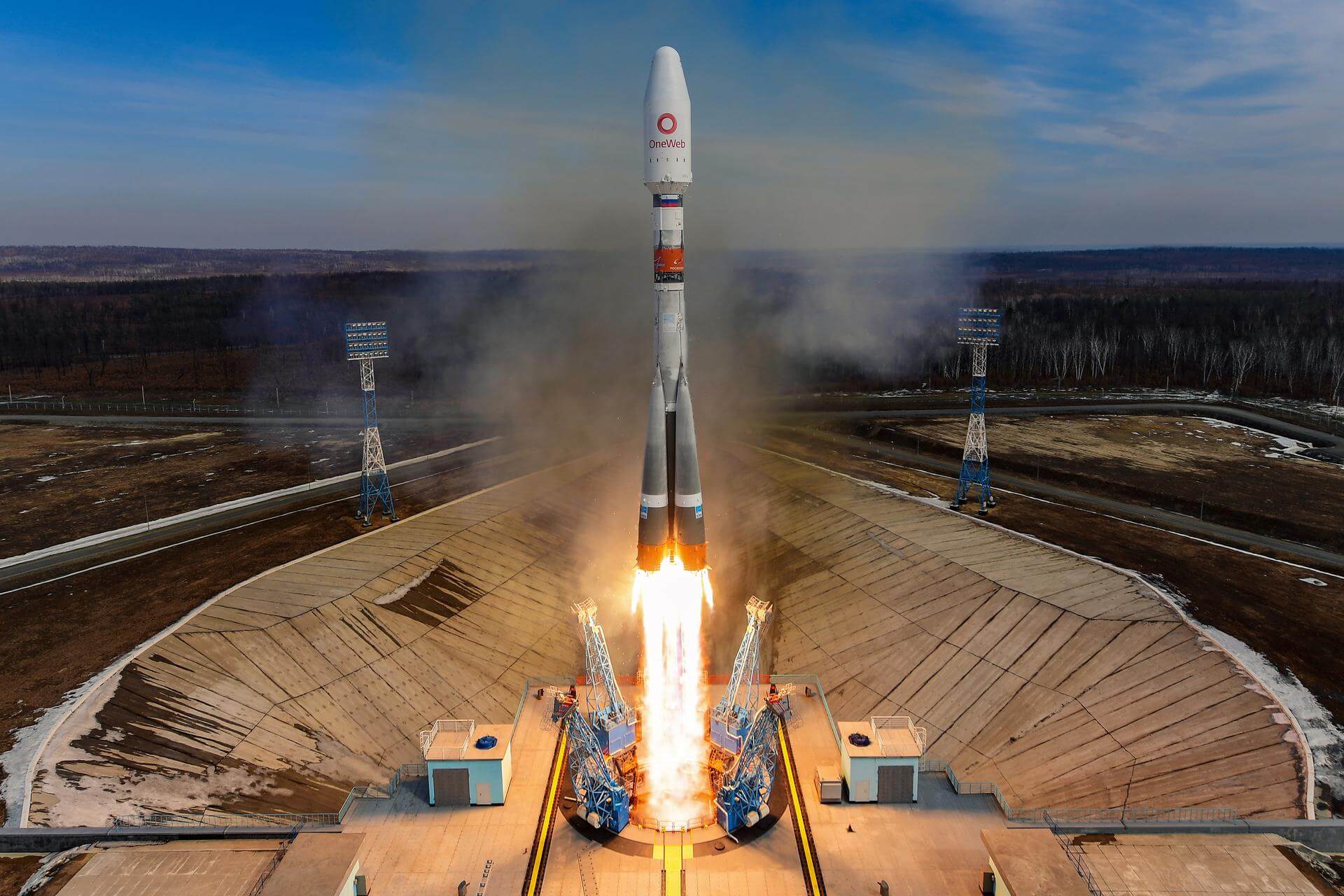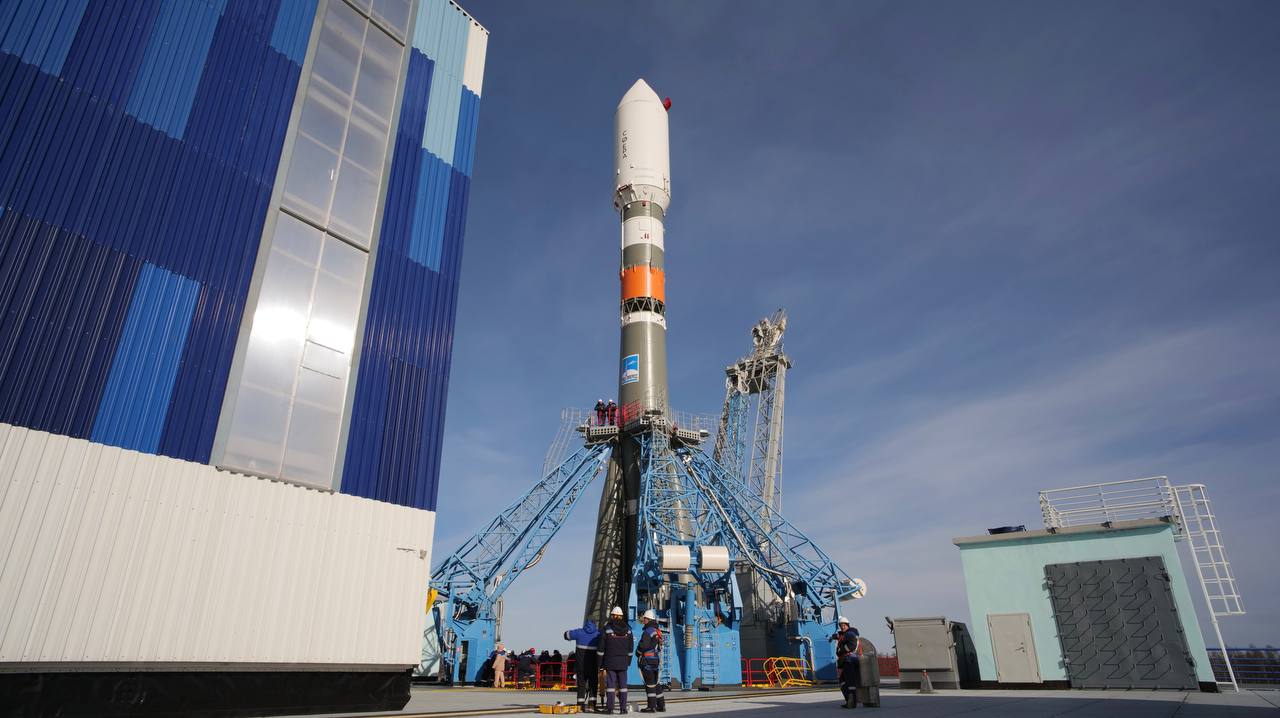
Soyuz 2.1b/Fregat-M
ActiveProgress Rocket Space Center (PRSC)
July 26, 2008
Description
Soyuz-2, GRAU index 14A14, is the collective designation for the 21st-century version of the Russian Soyuz rocket. In its basic form, it is a three-stage carrier rocket for placing payloads into low Earth orbit. The first-stage boosters and two core stages feature uprated engines with improved injection systems, compared to the previous versions of the Soyuz. Digital flight control and telemetry systems allow the rocket to be launched from a fixed launch platform, whereas the launch platforms for earlier Soyuz rockets had to be rotated as the rocket could not perform a roll to change its heading in flight.
Specifications
-
Stages
4 -
Length
46.3 m -
Diameter
10.3 m -
Fairing Diameter
4.11 m -
Launch Mass
313.0 T -
Thrust
4150.0 kN
Family
-
Name
Soyuz 2.1b/Fregat-M -
Family
― -
Variant
Fregat-M -
Alias
― -
Full Name
Soyuz 2.1b Fregat-M
Payload Capacity
-
Launch Cost
$48500000 -
Low Earth Orbit
8200.0 kg -
Geostationary Transfer
Orbit
3250.0 kg -
Direct Geostationary
― -
Sun-Synchronous Capacity
―
Progress Rocket Space Center
Commercial
CEO: Dmitry Baranov
PRSC 1996Progress Rocket Space Centre, formerly known as TsSKB-Progress, is a space science and aerospace research company which is known for manufacturing launch vehicles and satellites. Most notably, Progress Rocket Space Centre is the manufacturer of Soyuz launch vehicles.
Upcoming Spaceflights
Soyuz 2.1b/Fregat-M | AIST-2T 01 & 02
Progress Rocket Space Center | RussiaVostochny Cosmodrome, Siberia, Russian Federation
TBD March, 2026
Status: To Be Determined
Mission:
A pair of Russian optical Earth observation satellites built by the Progress Rocket Space Centre for obtaining stereo images of the Earth's surface, with maximum resolution of 1.2 m in panchromatic mode and a swath width of 32 km.
Sun-Synchronous OrbitSoyuz 2.1b/Fregat-M | Luna 26
Progress Rocket Space Center | RussiaVostochny Cosmodrome, Siberia, Russian Federation
TBD December, 2027
Status: To Be Determined
Mission:
Luna 26 (also named Luna-Resurs) is a planned lunar polar orbiter, part of the Luna-Glob program, by the Russian space agency Roscosmos. In addition to its scientific role, the Luna 26 orbiter would also function as a telecommunication relay between Earth and Russian landed assets. The scientific payload on board the orbiter is composed of fourteen instruments that will be fabricated by Russia. The payload will study the lunar surface and the environment around the Moon, including the solar wind, and high-energy cosmic rays. Luna 26 will also scout sites for the planned Luna 27 landing mission. Luna 26 is the second mission of Russia's new lunar program, which includes the launch of Luna 27, a heavy lander that will study the composition of the lunar soil by collecting several samples. Luna 28, a lunar samples return mission, will be the first to return samples at lunar temperature, and will serve as a demonstration for a future Martian samples return mission. Finally, Luna 29 should land a heavy lunar rover on the surface.
Lunar OrbitSoyuz 2.1b/Fregat-M | Luna 27
Progress Rocket Space Center | RussiaVostochny Cosmodrome, Siberia, Russian Federation
TBD December, 2028
Status: To Be Determined
Mission:
Luna 27 (also named Luna-Resurs 1) is a planned lunar lander mission by Roscosmos to send a lander to the South Pole–Aitken basin, an area on the far side of the Moon. The purpose is to prospect for minerals, volatiles (nitrogen, water, carbon dioxide, ammonia, hydrogen, methane and sulfur dioxide, and lunar water ice in permanently shadowed areas of the Moon and investigate the potential use of these natural lunar resources. On the long term, Russia considers building a crewed base on the Moon's far side that would bring scientific and commercial benefits. The lander will feature 15 science instruments that will analyse the regolith, plasma in the exosphere, dust, and seismic activity. The payload will include a sampling drill.
Lunar OrbitSoyuz 2.1b/Fregat-M | Ionosfera-M 3 & 4
Progress Rocket Space Center | RussiaVostochny Cosmodrome, Siberia, Russian Federation
July 25, 2025, 5:54 a.m.
Status: Launch Successful
Mission:
Ionosfera is a constellation of four ionospheric and magnetospheric research satellites developed by for Roscosmos for the project Ionozond. The satellites will operate on circular sun-synchronous orbits (SSO), at altitude of about 800 km and located in two orbital planes of two satellites each. The following science instruments are carried on the satellites: * SPER/1 Plasma and energy radiation spectrometer * SG/1 Gamma-ray spectrometer * GALS/1 Galactic cosmic ray spectrometer / 1 * LAERTES On-board Ionosonde * NBK/2 Low-frequency wave complex * ESEP Ionospheric plasma energy spectrometer * Ozonometer-TM Ozonometer * MayaK On-board radio transmitters * PES GPS-GLONASS device
Sun-Synchronous OrbitSoyuz 2.1b/Fregat-M | Kosmos 2588
Progress Rocket Space Center | RussiaPlesetsk Cosmodrome, Russian Federation
May 23, 2025, 8:36 a.m.
Soyuz 2.1b/Fregat-M | Glonass-K2 No. 14 (Kosmos 2584)
Progress Rocket Space Center | RussiaPlesetsk Cosmodrome, Russian Federation
March 2, 2025, 10:22 p.m.
Status: Launch Successful
Mission:
Glonass-K2 are the fourth generation of satellite design for GLONASS satellite navigation system. GLONASS is a Russian space-based navigation system comparable to the similar GPS and Galileo systems. This generation improves on accuracy, power consumption and design life. Each satellite is unpressurized and weighs 1645 kg, and has an operational lifetime of 10 years.
Medium Earth OrbitSoyuz 2.1b/Fregat-M | Ionosfera-M 1 & 2
Progress Rocket Space Center | RussiaVostochny Cosmodrome, Siberia, Russian Federation
Nov. 4, 2024, 11:18 p.m.
Status: Launch Successful
Mission:
Ionosfera is a constellation of four ionospheric and magnetospheric research satellites developed by for Roscosmos for the project Ionozond. The satellites will operate on circular sun-synchronous orbits (SSO), at altitude of about 800 km and located in two orbital planes of two satellites each. The following science instruments are carried on the satellites: * SPER/1 Plasma and energy radiation spectrometer * SG/1 Gamma-ray spectrometer * GALS/1 Galactic cosmic ray spectrometer / 1 * LAERTES On-board Ionosonde * NBK/2 Low-frequency wave complex * ESEP Ionospheric plasma energy spectrometer * Ozonometer-TM Ozonometer * MayaK On-board radio transmitters * PES GPS-GLONASS device The launch also include a secondary payload of 53 small satellites developed by various institutions and companies in Russia and other nations (including 2 from Iran) for technology demonstration, communication and Earth observation purposes.
Sun-Synchronous OrbitSoyuz 2.1b/Fregat-M | Kosmos 2576
Progress Rocket Space Center | RussiaPlesetsk Cosmodrome, Russian Federation
May 16, 2024, 9:21 p.m.
Soyuz 2.1b/Fregat-M | Meteor-M No.2-4 & others
Progress Rocket Space Center | RussiaVostochny Cosmodrome, Siberia, Russian Federation
Feb. 29, 2024, 5:43 a.m.
Soyuz 2.1b/Fregat-M | Arktika-M No.2
Progress Rocket Space Center | RussiaBaikonur Cosmodrome, Republic of Kazakhstan
Dec. 16, 2023, 9:17 a.m.
Soyuz 2.1b/Fregat-M | Luna 25
Progress Rocket Space Center | RussiaVostochny Cosmodrome, Siberia, Russian Federation
Aug. 10, 2023, 11:10 p.m.
Status: Launch Successful
Mission:
Luna 25 (ex-Luna-Glob) was a lunar lander mission by the Russian Federal Space Agency (Roscosmos) that crashed into the lunar surface after an anomalous orbital maneuver placed it on a collision trajectory towards the Moon. It was scheduled to land near the lunar south pole at the Boguslavsky crater to prove lunar landing technology. The mission carried 30 kg of scientific instruments, including a robotic arm for soil samples and possible drilling hardware. It was planned to remain active for at least one year on the lunar surface.
Lunar OrbitSoyuz 2.1b/Fregat-M | Glonass-K2 No. 13 (Kosmos 2569)
Progress Rocket Space Center | RussiaPlesetsk Cosmodrome, Russian Federation
Aug. 7, 2023, 1:19 p.m.
Status: Launch Successful
Mission:
Glonass-K2 are the fourth generation of satellite design for GLONASS satellite navigation system. GLONASS is a Russian space-based navigation system comparable to the similar GPS and Galileo systems. This generation improves on accuracy, power consumption and design life. Each satellite is unpressurized and weighs 1645 kg, and has an operational lifetime of 10 years.
Medium Earth OrbitSoyuz 2.1b/Fregat-M | Meteor-M No.2-3 & others
Progress Rocket Space Center | RussiaVostochny Cosmodrome, Siberia, Russian Federation
June 27, 2023, 11:34 a.m.
Status: Launch Successful
Mission:
Meteor-M satellites are a new generation of Russian meteorological satellites to replace the Meteor-3M series. The first two Meteor-M satellites will feature following instruments: - MSU-MR - Low-resolution Multispectral Scanner for global and regional for cloud cover mapping - KMSS-2 - multichannel scanning unit for Earth surface monitoring - MTVZA-GYa - imager/sounder for Atmospheric temperature and humidity profiles, sea surface wind - IKFS-2 advanced IR sounder for Atmospheric temperature and humidity profiles - BRK SSPD - Data Collection System - RK-SM-MKA - Modified Rescue Radio complex One initial Meteor-M 1 satellite was built, followed by the improved Meteor-M 2 series satellites. 42 cubesats from various Russian and international organizations will be launched as co-passengers.
Sun-Synchronous OrbitSoyuz 2.1b/Fregat-M | Glonass-M No. 61 (Kosmos 2564)
Progress Rocket Space Center | RussiaPlesetsk Cosmodrome, Russian Federation
Nov. 28, 2022, 3:13 p.m.
Status: Launch Successful
Mission:
Glonass-M, also known as Uragan-M, are the second generation of Uragan satellite design used for GLONASS satellite navigation system. GLONASS is a Russian space-based navigation system comparable to the similar GPS and Galileo systems. This generation improves on accuracy, power consumption and design life. Each satellite weighs 1415 kg, is equipped with 12 L-band antennas, and has an operational lifetime of 7 years.
Medium Earth OrbitSoyuz 2.1b/Fregat-M | Gonets-M33, Gonets-M34, Gonets-M35 & Skif-D
Progress Rocket Space Center | RussiaVostochny Cosmodrome, Siberia, Russian Federation
Oct. 22, 2022, 7:57 p.m.
Status: Launch Successful
Mission:
Gonets-M are an upgraded version of Gonets satellites, derived from military communications system Strela-3. Gonets-M constellation is tasked with monitoring ecological and industrial objects, providing communication and data transmission services, covering also the remote areas like the Far North region. Also onboard is the Skif-D demonstration satellite for the planned Russian Sfera LEO communication satellite constellation.
Low Earth OrbitSoyuz 2.1b/Fregat-M | Khayyam & rideshare
Progress Rocket Space Center | RussiaBaikonur Cosmodrome, Republic of Kazakhstan
Aug. 9, 2022, 5:52 a.m.
Status: Launch Successful
Mission:
Khayyam, also known as Project 505, is a Russian built Earth observation satellite for Iran. The satellite is built by VNIIEM and NPK Barl on a currently unidentified satellite bus, with resolution reaching < 1 m. 16 Russian cubesats from various institutions/universities are also arranged for launch as secondary payload by Aerospace Capital.
Sun-Synchronous OrbitSoyuz 2.1b/Fregat-M | OneWeb 12
Progress Rocket Space Center | RussiaBaikonur Cosmodrome, Republic of Kazakhstan
Dec. 27, 2021, 1:10 p.m.
Status: Launch Successful
Mission:
A batch of 36 satellites for the OneWeb satellite constellation, which is intended to provide global Internet broadband service for individual consumers. The constellation is planned to have around 648 microsatellites (of which 60 are spares), around 150 kg each, operating in Ku-band from low Earth orbit.
Polar OrbitSoyuz 2.1b/Fregat-M | OneWeb 10
Progress Rocket Space Center | RussiaBaikonur Cosmodrome, Republic of Kazakhstan
Sept. 14, 2021, 6:07 p.m.
Status: Launch Successful
Mission:
A batch of 34 satellites for the OneWeb satellite constellation, which is intended to provide global Internet broadband service for individual consumers. The constellation is planned to have around 648 microsatellites (of which 60 are spares), around 150 kg each, operating in Ku-band from low Earth orbit.
Polar OrbitSoyuz 2.1b/Fregat-M | OneWeb 9
Progress Rocket Space Center | RussiaBaikonur Cosmodrome, Republic of Kazakhstan
Aug. 21, 2021, 10:13 p.m.
Status: Launch Successful
Mission:
A batch of 34 satellites for the OneWeb satellite constellation, which is intended to provide global Internet broadband service for individual consumers. The constellation is planned to have around 648 microsatellites (of which 60 are spares), around 150 kg each, operating in Ku-band from low Earth orbit.
Polar OrbitSoyuz 2.1b/Fregat-M | OneWeb 8
Progress Rocket Space Center | RussiaVostochny Cosmodrome, Siberia, Russian Federation
July 1, 2021, 12:48 p.m.
Status: Launch Successful
Mission:
A batch of 36 satellites for the OneWeb satellite constellation, which is intended to provide global Internet broadband service for individual consumers. The constellation is planned to have around 648 microsatellites (of which 60 are spares), around 150 kg each, operating in Ku-band from low Earth orbit.
Polar OrbitSoyuz 2.1b/Fregat-M | OneWeb 7
Progress Rocket Space Center | RussiaVostochny Cosmodrome, Siberia, Russian Federation
May 28, 2021, 5:38 p.m.
Status: Launch Successful
Mission:
A batch of 36 satellites for the OneWeb satellite constellation, which is intended to provide global Internet broadband service for individual consumers. The constellation is planned to have around 648 microsatellites (of which 60 are spares), around 150 kg each, operating in Ku-band from low Earth orbit.
Polar OrbitSoyuz 2.1b/Fregat-M | OneWeb 6
Progress Rocket Space Center | RussiaVostochny Cosmodrome, Siberia, Russian Federation
April 25, 2021, 10:14 p.m.
Status: Launch Successful
Mission:
A batch of 36 satellites for the OneWeb satellite constellation, which is intended to provide global Internet broadband service for individual consumers. The constellation is planned to have around 648 microsatellites (of which 60 are spares), around 150 kg each, operating in Ku-band from low Earth orbit.
Polar OrbitSoyuz 2.1b/Fregat-M | OneWeb 5
Progress Rocket Space Center | RussiaVostochny Cosmodrome, Siberia, Russian Federation
March 25, 2021, 2:47 a.m.
Status: Launch Successful
Mission:
A batch of 36 satellites for the OneWeb satellite constellation, which is intended to provide global Internet broadband service for individual consumers. The constellation is planned to have around 648 microsatellites (of which 60 are spares), around 150 kg each, operating in Ku-band from low Earth orbit.
Polar OrbitSoyuz 2.1b/Fregat-M | Arktika-M No.1
Progress Rocket Space Center | RussiaBaikonur Cosmodrome, Republic of Kazakhstan
Feb. 28, 2021, 6:55 a.m.
Soyuz 2.1b/Fregat-M | OneWeb 4
Progress Rocket Space Center | RussiaVostochny Cosmodrome, Siberia, Russian Federation
Dec. 18, 2020, 12:26 p.m.
Status: Launch Successful
Mission:
A batch of 36 satellites for the OneWeb satellite constellation, which is intended to provide global Internet broadband service for individual consumers. The constellation is planned to have around 648 microsatellites (of which 60 are spares), around 150 kg each, operating in Ku-band from low Earth orbit.
Polar OrbitSoyuz 2.1b/Fregat-M | Gonets-M30, Gonets-M31, Gonets-M32
Progress Rocket Space Center | RussiaPlesetsk Cosmodrome, Russian Federation
Dec. 3, 2020, 1:14 a.m.
Status: Launch Successful
Mission:
Gonets-M are an upgraded version of Gonets satellites, derived from military communications system Strela-3. Gonets-M constellation is tasked with monitoring ecological and industrial objects, providing communication and data transmission services, covering also the remote areas like the Far North region.
Low Earth OrbitSoyuz 2.1b/Fregat-M | Gonets-M27, Gonets-M28, Gonets-M29 & others
Progress Rocket Space Center | RussiaPlesetsk Cosmodrome, Russian Federation
Sept. 28, 2020, 11:20 a.m.
Status: Launch Successful
Mission:
Gonets-M are an upgraded version of Gonets satellites, derived from military communications system Strela-3. Gonets-M constellation is tasked with monitoring ecological and industrial objects, providing communication and data transmission services, covering also the remote areas like the Far North region. This launch also carries 22 small satellites as a rideshare payloads. These are cubesats for commercial companies such as Spire and Kepler Communications, as well as cubesats for various international universities.
Low Earth OrbitSoyuz 2.1b/Fregat-M | OneWeb 3
Progress Rocket Space Center | RussiaBaikonur Cosmodrome, Republic of Kazakhstan
March 21, 2020, 5:06 p.m.
Status: Launch Successful
Mission:
A batch of 34 satellites for the OneWeb satellite constellation, which is intended to provide global Internet broadband service for individual consumers. The constellation is planned to have around 648 microsatellites (of which 60 are spares), around 150 kg each, operating in Ku-band from low Earth orbit. Eventually it can be expanded to include extra 1260 satellites, for a total of 1908.
Polar OrbitSoyuz 2.1b/Fregat-M | Glonass-M No. 60 (Kosmos 2545)
Progress Rocket Space Center | RussiaPlesetsk Cosmodrome, Russian Federation
March 16, 2020, 6:28 p.m.
Status: Launch Successful
Mission:
Glonass-M, also known as Uragan-M, are the second generation of Uragan satellite design used for GLONASS satellite navigation system. GLONASS is a Russian space-based navigation system comparable to the similar GPS and Galileo systems. This generation improves on accuracy, power consumption and design life. Each satellite weighs 1415 kg, is equipped with 12 L-band antennas, and has an operational lifetime of 7 years.
Medium Earth OrbitSoyuz 2.1b/Fregat-M | OneWeb 2
Progress Rocket Space Center | RussiaBaikonur Cosmodrome, Republic of Kazakhstan
Feb. 6, 2020, 9:42 p.m.
Status: Launch Successful
Mission:
A batch of 34 satellites for the OneWeb satellite constellation, which is intended to provide global Internet broadband service for individual consumers. The constellation is planned to have around 648 microsatellites (of which 60 are spares), around 150 kg each, operating in Ku-band from low Earth orbit. Eventually it can be expanded to include extra 1260 satellites, for a total of 1908.
Polar OrbitSoyuz 2.1b/Fregat-M | Glonass-M No. 59 (Kosmos 2544)
Progress Rocket Space Center | RussiaPlesetsk Cosmodrome, Russian Federation
Dec. 11, 2019, 8:54 a.m.
Status: Launch Successful
Mission:
Glonass-M, also known as Uragan-M, are the second generation of Uragan satellite design used for GLONASS satellite navigation system. GLONASS is a Russian space-based navigation system comparable to the similar GPS and Galileo systems. This generation improves on accuracy, power consumption and design life. Each satellite weighs 1415 kg, is equipped with 12 L-band antennas, and has an operational lifetime of 7 years.
Medium Earth OrbitSoyuz 2.1b/Fregat-M | Glonass-M No. 58 (Kosmos 2534)
Progress Rocket Space Center | RussiaPlesetsk Cosmodrome, Russian Federation
May 27, 2019, 6:23 a.m.
Status: Launch Successful
Mission:
Glonass-M, also known as Uragan-M, are the second generation of Uragan satellite design used for GLONASS satellite navigation system. GLONASS is a Russian space-based navigation system comparable to the similar GPS and Galileo systems. This generation improves on accuracy, power consumption and design life. Each satellite weighs 1415 kg, is equipped with 12 L-band antennas, and has an operational lifetime of 7 years.
Medium Earth OrbitSoyuz 2.1b/Fregat-M | EgyptSat-A
Progress Rocket Space Center | RussiaBaikonur Cosmodrome, Republic of Kazakhstan
Feb. 21, 2019, 4:47 p.m.
Status: Launch Successful
Mission:
EgyptSat-A (MisrSat A) is Egypt's third Earth remote-sounding satellite. The satellite is jointly built by Egypt's National Authority for Remote Sensing and Space Sciences together with RKK Energiya in Russia. The imaging payload was developed by OAO Peleng and NIRUP Geoinformatsionnye Sistemy in Belarus. The satellite is an improved version of EgyptSat 2 and is also based on RKK Energiya's 559GK bus, which inherits technologies from their USP platform. The satellite features SPD-70 electric engines using Xenon. It features an improved opto-electronic system and onboard control system, high-speed on-board radio link and solar cells with increased efficiency.
Low Earth OrbitSoyuz 2.1b/Fregat-M | Glonass-M No. 57 (Kosmos 2529)
Progress Rocket Space Center | RussiaPlesetsk Cosmodrome, Russian Federation
Nov. 3, 2018, 8:17 p.m.
Status: Launch Successful
Mission:
Glonass-M, also known as Uragan-M, are the second generation of Uragan satellite design used for GLONASS satellite navigation system. GLONASS is a Russian space-based navigation system comparable to the similar GPS and Galileo systems. This generation improves on accuracy, power consumption and design life. Each satellite weighs 1415 kg, is equipped with 12 L-band antennas, and has an operational lifetime of 7 years.
Medium Earth OrbitSoyuz 2.1b/Fregat-M | Glonass-M No. 56 (Kosmos 2527)
Progress Rocket Space Center | RussiaPlesetsk Cosmodrome, Russian Federation
June 16, 2018, 9:46 p.m.
Soyuz-2.1b/Fregat-M | Glonass-M (Kosmos 2522)
Progress Rocket Space Center | RussiaPlesetsk Cosmodrome, Russian Federation
Sept. 22, 2017, 12:02 a.m.
Status: Launch Successful
Mission:
Glonass-M, also known as Uragan-M, are the second generation of Uragan satellite design used for GLONASS satellite navigation system. GLONASS is a Russian space-based navigation system comparable to the similar GPS and Galileo systems. This generation improves on accuracy, power consumption and design life. Each satellite weighs 1415 kg, is equipped with 12 L-band antennas, and has an operational lifetime of 7 years.
Medium Earth OrbitFalcon 9
Starlink Group 11-15
Space Launch Complex 4E - Vandenberg SFB, CA, USAA batch of 28 satellites for the Starlink mega-constellation - SpaceX's project for space-based Internet communication system.
Long March 8A
SatNet LEO Group 14
Commercial LC-1 - Wenchang Space Launch Site, People's Republic of ChinaA batch of 9 Low Earth Orbit communication satellites for the Chinese state owned SatNet constellation operated by the China Satellite Network Group.…
Kuaizhou-1A
Traffic VDES A & B
Launch Area 95A - Jiuquan Satellite Launch Center, People's Republic of ChinaTwo technology demonstration satellites for satellite transmissions of signals for the VHF Data Exchange System (VDES), a successor to the current Au…
Falcon 9
Starlink Group 11-25
Space Launch Complex 4E - Vandenberg SFB, CA, USAA batch of 28 satellites for the Starlink mega-constellation - SpaceX's project for space-based Internet communication system.
Zhuque-3
Demo Flight
Launch Area 96B - Jiuquan Satellite Launch Center, People's Republic of ChinaFirst test launch of LandSpace’s ZQ-3 rocket, with a dummy payload. The rocket’s 1st stage will attempt to land on a landing pad about 300 km downran…
